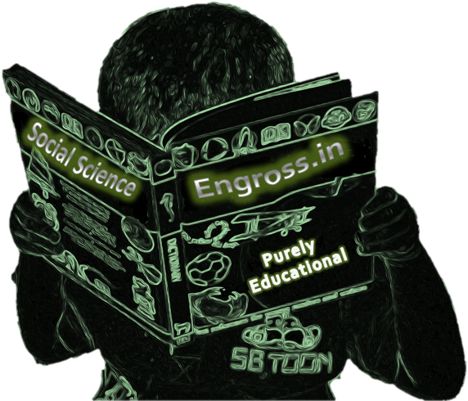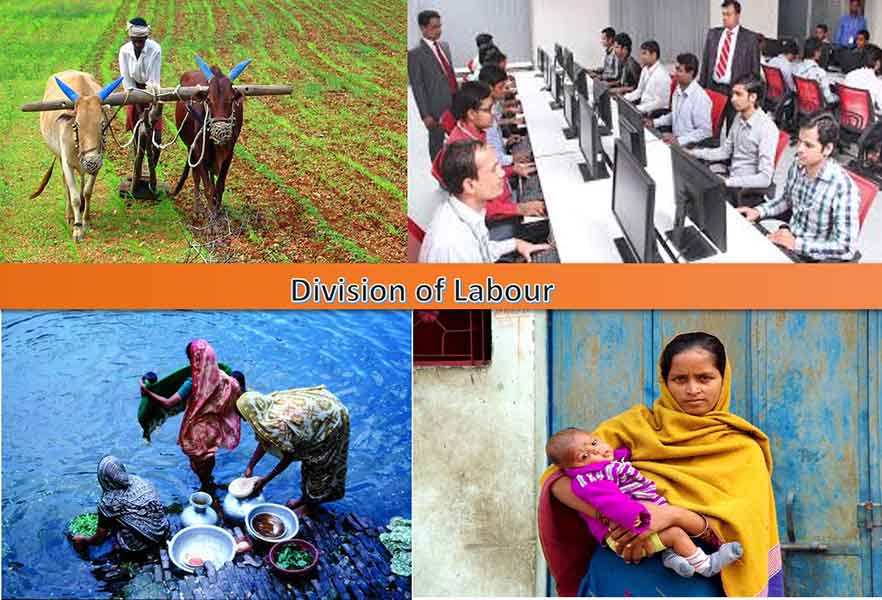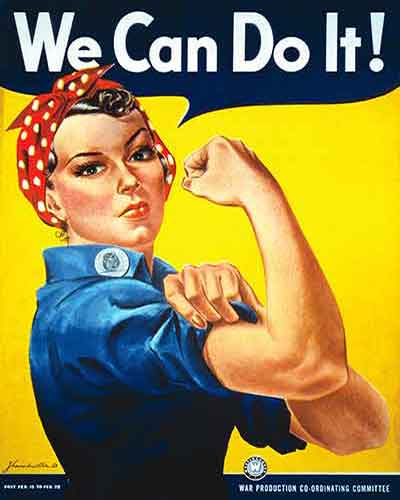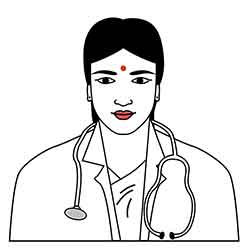Sexual Division of Labour
- There is a common belief that gender division is natural and unchangeable.
- Boys and girls are brought up to believe that certain sets of jobs are to be done only by men and women are expected to do different sets of jobs.
- Men are expected to work outside to earn money. Women are expected to take care of homes and look of the children. This division of labour is called sexual division of labour.
- This division is not biological division; it is merely a social division caused by expectations and stereo types.
- It is not that men cannot do the work of women. They do it only if there are monetary gains. Most cooks and tailors are men.
- Similarly, it is not that women do not work outside their homes.
- In villages, apart from working at home, women also work outside as agricultural labourers.
- In urban centres, middle-class women work in offices. Women from lower classes work in the houses of middle-class families.
Feminist Movements
- Social movements that aim at establishing equality between men and women are called feminist movements.
- For a long period, only men could participate in public affairs, vote and contest in elections.
- Gradually gender issue was raised in politics.
- Women in different parts of the world organised and agitated for equal rights. These agitations demanded enhancing the political and legal status of women and improving their educational and career opportunities.
Outcome of Feminist Movements
- Political expression of gender has helped to improve women’s role in public life.
- Now women work as scientists, doctors, engineers, lawyers, managers, college and university professors.
- In some parts of the world, like the Scandinavian countries such as Sweden, Norway and Finland, the participation of women in public life is very high.
Indian society continuous to be male dominant and families patriarchal
The literacy rate among women is only 70.30% compared with 84.70% among men (NSO). There is high drop out of girl students because parents prefer to spend their resources on boys’ education rather than girls’ education.
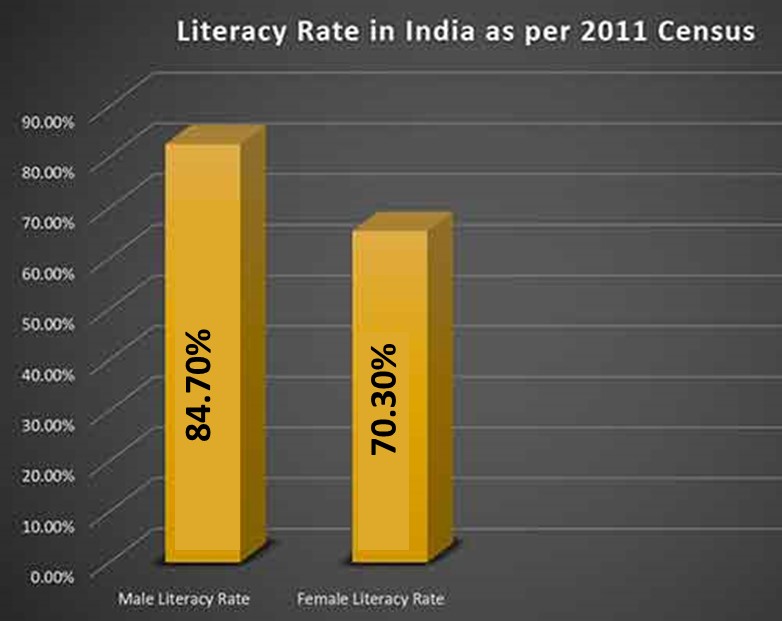
- There is very low percentage of women in the high paid and high value jobs, as just a few girls are encouraged to take up higher education.
- Despite the Equal Wages Act of 1976, women in all areas are paid lesser than men, be it sports, cinema, agriculture or construction works.
- Most parents prefer boy children to girl children. Female infanticide and feticide are common in our country. This has resulted in unfavourable sex ratio.
- Political representation of women in India is very low. It has never crossed 5% in any of the Vidhana Sabhas and never crossed 14.8% in Loka Sabha.
- Society in general and urban centres in particular, is not safe for women. Dowry harassment, physical abuse, sexual harassment are routine tales.
- Political representation of women has given us some good results but there is still a lot to achieve.
Steps taken to improve Political Representation of Women.
- 1/3 seats are reserved for women in Local Self Governments.
- Women’s bill was introduced in the Parliament long ago. It has been passed by the Rajya Sabha. Loka Sabha is yet to pass it.
Rest of the lesson is delt with in the form of questions and answers for your benefit
1. What arguements are putforth to show that Religion and Politics cannot be separated?
Ans:
- Though, social division based on religion is not as universal as gender, it is fairly widespread.
- There are people following different religion in most countries as in our country.
- There can be serious differences in the way one religion is practiced, as in the case of Northern Ireland, between the Protestants and Catholics.
- Gandhiji used to say that religion and politics cannot be separated. According to him the values of all religion should guide politics.
- Human rights activists allege that people from minority religious community suffer a lot whenever there is communal violence.
- Feminists have argued that Family Laws of all religions discriminate women. They have demanded that government should change these laws to make them more equitable.
2. What is Communalism?
Ans:
Extreme and partisan attachment to one’s own religion is called Communalism. A communal person hates other religions and the people of other religions. He is a person of singular identity.
3. What is Communal Politics?
Ans:
- Problem in the society begins when one religion is seen as the foundation of a nation.
- The problem intensifies when people of different religion are pitted against one another.
- This happens when one religion and the people of that religion are shown as superior to other religions and the people of other religions.
- The problem becomes serious when demands of one religious group is formed in opposition to other religions.
- The problem becomes very acute when the Government uses its power to fulfil the demands of only one religious group.
This kind of using religion is politics is called Communal Politics
4. Explain the Theory of Communal Politics. How do you say that this theory is wrong?
Ans:
- Religion is the main basis of formation of the society.
- The followers of a religion must form one community.
- Their fundamental interests are the same.
- If there are any differences, they should not matter and come in the way of community life.
- People following different religions cannot belong to the same social community.
- If there are similarities among the people of different religions, these are superficial, and differences are bound to be there.
- The majority community should rule the country. The minority should accept the rule or form a different state.
- This is the theory of Communal Politics.
Why is this wrong?
- This theory is wrong because this theory is divisive in nature – it divides people; doesn’t unite them.
- People of the same religion do not have same interest and aspirations in every context.
- Everyone has different identities in different contexts.
- There are many voices inside every community. All the voices have the right to be heard.
5. Explain the various forms that Communalism takes in Politics.
Ans:
- The most common expression of communalism is in every beliefs and practices. This includes religious prejudices, stereotyping religious communities and belief in in the superiority of one’s religion over the others.
- For the majority community, it takes the forms of Majoritarianism and for the minority it takes the form of desire to form a different state.
- Political mobilisation on religious and lines is another frequent form of communalism. Using sacred symbols, religious leaders, emotional appeal and plain fear to get votes are some ways in which communalism is expressed.
- Communal violence is the worst form that communalism can take in politics. India has witnessed the worst communal violence during the partition. Even of the independence, India has witnessed many communal violence.
6. What steps have been taken to combat communalism in India?
Ans:
- India is a secular state. There is no official religion or state religion in India.
- Everyone is free to practice, profess and propagate any religion.
- The constitution prohibits discrimination on grounds of religion.
- The constitution allows the state to intervene in the religious matters to ensure equality within religious communities. For example, it bans untouchability.
7. What are the reasons for breaking down of caste system in India?
Ans:
- The efforts of great social reformers like Jotiba Phule, Gandhiji, B.R. Ambedkar and Periyar Ramaswamy Naicker have contributed a lot in this regard.
- Socio-economic changes that took place in the 20th C also have played a major role. They are as follows:
- Urbanisation :Nobody bothers about the caste of a person walking next to us or of the family eating at the next table in a restaurant.
- Occupational mobility: Occupation of a person is no longer detrmined by birth. Heriditory transfer of occupation has stopped. Today, no one cares about which person belonging to which caste does what work.
- Growth of literacy and education: Education has created awareness among the people about the ill effect of caste based exploitation.
- Breaking down of caste hierarchy: There used to be hierarchical set up of caste in rural areas. That has broken down. People know their rights.
- Govt. Policies and laws: Govt. policies like reservation for the lower castes and laws like banning untouchability also have played their role in eroding casteism in the 20th C.
8. How do you say that the effects of century old practice of casteism is felt even today?
Ans:
- Most people prefer to marry within their own caste or tribe.
- Untouchability has not ended a completely.
- The caste groups that had access to education have quickly adapted to modern education and have continue to do well.
- The caste groups that were denied of education are naturally lagging.
- There is direct relationship between a person’s caste and his economic status.
- There is high percentage of SCs, STs and OBCs in the BPL category.
9. How do you say that the outcome of Indian Elections is not determined by Caste alone?
Ans:
- No parliamentary constituency in the country has a clear majority of one single caste. Every candidate needs the votes of people of different caste groups.
- No party wins the votes of all the voters of a caste our community.
- Many political parties may give tickets to the persons belonging the majority caste group. If that caste group has many to choose from, the other caste groups have none, if they were to vote only on the basis of caste. In both situations, people are compelled to think beyond caste.
- The ruling party MLAs and MPs frequently lose elections. This shows that the people of India are not frozen in their political choice.
- A person’s attachment to his party and the party ideology can be stronger than his attachment to his caste group. This is the reason why people of the same family vote for different political parties. People of the same caste group have different political preferences. You also find political leaders belonging to different caste groups working in one single political party.
10. How does caste Influence Politics? OR What role does caste play in politics? OR How does Caste manifest itself in Politics?
Ans:
- When parties choose candidates in elections, they keep in mind the caste the composition of the constituency. Usually, the person belonging to the majority caste gets the ticket. When the cabinet is formed, all caste groups and tribes are included in the cabinet.
- Political parties and candidates appeal to the caste sentiment of the people. Some political parties are known to favour some castes and are seen as their representatives.
- Universal adult franchise and the principal of one person, one vote and one value has compelled political parties to mobilise the support of all caste groups.
- This has created a new consciousness among the people of different caste groups that were ill-treated for long. In other words, people of all caste groups including the ill-treated caste groups know that their votes matter a lot, and in many constituencies and states their votes are the deciding factors.
11. How deos Politics influence Caste?
Ans:
- It is not politics that gets caste ridden, it is the caste that gets politicised. Let’s see how.
- Each caste group tries to become bigger by incorporating nearby castes that were excluded earlier.
- Various caste groups form coalition with other caste groups to maximise the benefits extended by the government.
- New kinds of caste groups have come up in the political arena like ‘backward’ and ‘forward’ castes.
12. What are the Outcomes of Political Expression of Caste?
Ans:
- It has provided space and opportunity for the disadvantaged groups to demand their share in power.
- Thus, it has helped Dalits and OBCs to gain better access to decision making.
- It also has helped them to fight for social justice.
- Exclusive attention to caste can produce negative results also.
- Caste based politics is certainly not healthy in democracy.
- It can divert attention from other important issues like poverty, development and corruption. It can also lead to tensions, conflicts and violence.
